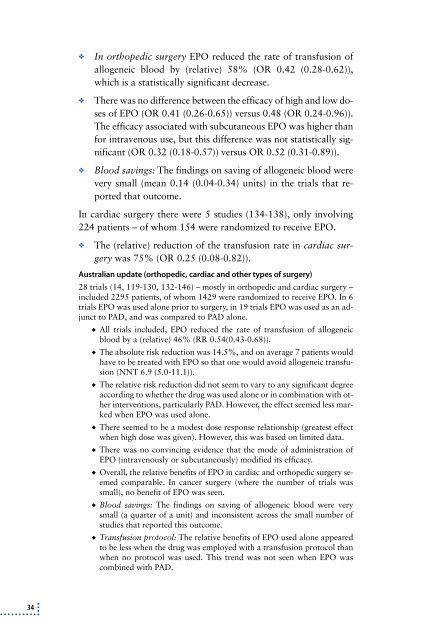Elektronisk udgave - Sundhedsstyrelsen
Elektronisk udgave - Sundhedsstyrelsen
Elektronisk udgave - Sundhedsstyrelsen
Create successful ePaper yourself
Turn your PDF publications into a flip-book with our unique Google optimized e-Paper software.
34<br />
❖ In orthopedic surgery EPO reduced the rate of transfusion of<br />
allogeneic blood by (relative) 58% (OR 0.42 (0.28-0.62)),<br />
which is a statistically significant decrease.<br />
❖ There was no difference between the efficacy of high and low doses<br />
of EPO (OR 0.41 (0.26-0.65)) versus 0.48 (OR 0.24-0.96)).<br />
The efficacy associated with subcutaneous EPO was higher than<br />
for intravenous use, but this difference was not statistically significant<br />
(OR 0.32 (0.18-0.57)) versus OR 0.52 (0.31-0.89)).<br />
❖ Blood savings: The findings on saving of allogeneic blood were<br />
very small (mean 0.14 (0.04-0.34) units) in the trials that reported<br />
that outcome.<br />
In cardiac surgery there were 5 studies (134-138), only involving<br />
224 patients – of whom 154 were randomized to receive EPO.<br />
❖ The (relative) reduction of the transfusion rate in cardiac surgery<br />
was 75% (OR 0.25 (0.08-0.82)).<br />
Australian update (orthopedic, cardiac and other types of surgery)<br />
28 trials (14, 119-130, 132-146) – mostly in orthopedic and cardiac surgery –<br />
included 2295 patients, of whom 1429 were randomized to receive EPO. In 6<br />
trials EPO was used alone prior to surgery, in 19 trials EPO was used as an adjunct<br />
to PAD, and was compared to PAD alone.<br />
◆ All trials included, EPO reduced the rate of transfusion of allogeneic<br />
blood by a (relative) 46% (RR 0.54(0.43-0.68)).<br />
◆ The absolute risk reduction was 14.5%, and on average 7 patients would<br />
have to be treated with EPO so that one would avoid allogeneic transfusion<br />
(NNT 6.9 (5.0-11.1)).<br />
◆ The relative risk reduction did not seem to vary to any significant degree<br />
according to whether the drug was used alone or in combination with other<br />
interventions, particularly PAD. However, the effect seemed less marked<br />
when EPO was used alone.<br />
◆ There seemed to be a modest dose response relationship (greatest effect<br />
when high dose was given). However, this was based on limited data.<br />
◆ There was no convincing evidence that the mode of administration of<br />
EPO (intravenously or subcutaneously) modified its efficacy.<br />
◆ Overall, the relative benefits of EPO in cardiac and orthopedic surgery seemed<br />
comparable. In cancer surgery (where the number of trials was<br />
small), no benefit of EPO was seen.<br />
◆ Blood savings: The findings on saving of allogeneic blood were very<br />
small (a quarter of a unit) and inconsistent across the small number of<br />
studies that reported this outcome.<br />
◆ Transfusion protocol: The relative benefits of EPO used alone appeared<br />
to be less when the drug was employed with a transfusion protocol than<br />
when no protocol was used. This trend was not seen when EPO was<br />
combined with PAD.

















